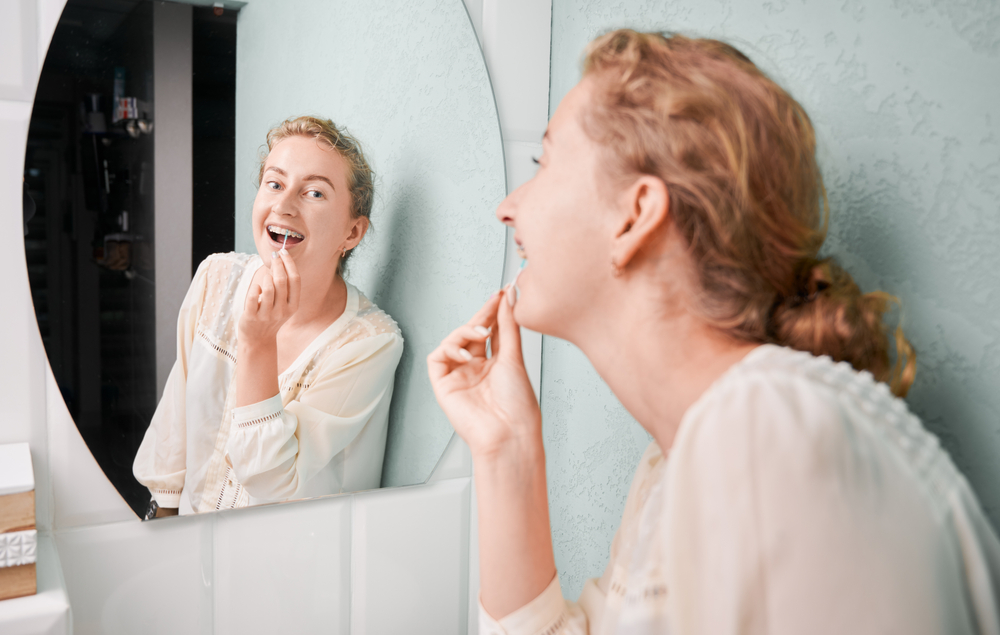
The Ultimate Guite To Floss With Braces
When our Alaska, Bothell, Monroe and Mill Creek braces patients first kick-off treatment, we always teach them exactly how to take care of their braces and their smile. Of course, knowing what to do and actually learning new techniques are two different things. For most people, figuring out how to floss with braces takes the most getting used to. To help give you a better idea, we’ll be sharing everything you need to know about flossing with your hardware.
While our Invisalign® patients should floss their teeth too, one of the benefits of Invisalign vs. braces is the aligners are removable, so you can floss your teeth with regular old dental floss just as you normally would. For that reason, this information is geared towards those with braces.
In this post, we’ll cover:
Why is Flossing With Braces So Important?
Whether you have braces or not, flossing your teeth every day is crucial to maintaining your oral health. Flossing gets rid of plaque and food debris between the teeth and along the gumline that your toothbrush can’t reach. In fact, flossing is responsible for about 40% of plaque removal. Together, brushing and flossing lower your risk of tooth decay and gum disease.
When you have braces on your teeth, there are more places for plaque, bacteria and food to hide. If you don’t practice good oral hygiene with braces, you are more likely to get cavities or experience gum inflammation. In extreme cases, you could have to have your braces removed to have your dental problems treated, which would extend your braces treatment time. Additionally, teeth move most effectively in a healthy oral environment. So, diligent brushing and flossing will help you get the best braces results and finish your treatment on schedule.
How Often Do You Need to Floss Your Teeth With Braces?
We recommend flossing at least once a day when you have braces. You can break out your dental floss or orthodontic flosser whenever you have time and there are no hard and fast rules about what time of day to floss. However, flossing at night is a good way to eliminate the plaque, bacteria and food particles that have accumulated throughout the day.
Should You Floss or Brush First?
Now, should you floss or brush first? A 2018 study published in the Journal of Periodontology on the efficacy of flossing before or after brushing found flossing before brushing removed significantly more plaque from in between the teeth and in the mouth overall. Subjects who flossed before brushing also had a higher concentration of fluoride from their toothpaste. The fluoride helps to further zap plaque and strengthen enamel. So, our advice is to floss first and then brush if possible.
What is the Best Floss for Braces?
It is a good idea to use a waxed dental floss because your brackets and wires can shred unwaxed floss. Unwaxed floss is also more likely to get stuck in your braces. Other than that, the best floss for braces is really a personal preference.
Some patients do like traditional dental floss, but using a floss threader will get the job done much quicker. An orthodontic flosser (like a Platypus flosser) is the fastest option of them all and will really cut down on the time you spend flossing with braces.
While you can absolutely use a Waterpik, technically called a water flosser, when you have braces, and we would recommend adding it to your oral hygiene routine, a Waterpik does not replace regular flossing with dental floss or an orthodontic flosser. It’s something you’ll do in addition to your daily flossing, but most patients find it’s well worth it, because it helps get their teeth and gums feeling squeaky clean.
How to Floss With Braces Using Traditional Dental Floss
As we said, flossing with traditional dental floss will take longer when you have braces than it will if you use a floss threader or orthodontic flosser. However, if you have your heart set on using regular floss to floss with braces, it’s possible.
Here’s how:
- Break off a length of waxed dental floss about 18 inches long.
- Using one hand, carefully thread one end of the floss between your arch wire and your teeth. With your other hand, grasp the end of the floss as it makes its way through.
- Wrap the ends of the dental floss around your index fingers. You can also wrap it around your middle fingers, leaving only a few inches to use between your teeth, and hold the floss tight with your thumbs and index fingers.
- Position the floss between any two teeth.
- Glide the floss up and down the side of one tooth, making a C-shape at the base of the tooth when you reach the gums to gently floss the area between your gums and tooth. Then, floss up and down the side of the other tooth, repeating the C-shape to get just under the gum line.
- Remove the floss and unthread it behind your archwire.
- Repeat the process on the next set of teeth using a clean section of floss until you’ve flossed all of your teeth, including behind your back molars.
How to Floss With Braces Using a Floss Threader
A floss threader will make flossing with braces just a bit easier. It’s a piece of flexible plastic with a loop on the end that transforms regular floss into floss for braces or restorations like fixed bridgework. There are also versions like Super Floss that have a stiffened end.
As for how to use a floss threader to floss with braces, follow these steps:
- Break off a piece of waxed dental floss about 18 inches long.
- Direct one end of your floss through the eye of the floss threader and pull about five inches of the floss through the loop.
- Carefully direct the pointed end of your floss threader under your archwire. If you’re using Super Floss, guide the stiffened end of the floss under your wire. Pull the floss through so you can grip it with both hands.
- Wrap the floss around your index fingers, leaving a few inches to floss between your teeth with.
- Position the floss between any two teeth.
- Slide the floss up and down the side of one tooth, making a C-shape at the base of the tooth when you reach the gums to gently floss the area between your gums and tooth. Then, floss up and down the side of the other tooth, getting just under the gumline again.
- Gently pull the floss out from behind your archwire.
- Use your floss threader again to floss in between your next set of teeth. Repeat the process until you’ve flossed all of your teeth, including around your back molars.
How to Floss Using an Orthodontic Flosser
An orthodontic flosser is the easiest, quickest way to floss with braces. However, it is more expensive than regular dental floss.
Here’s how to floss with an orthodontic flosser if you go that route:
- Slide the rounded end of your orthodontic flosser under your archwire so the floss is positioned between two teeth.
- Glide the floss up and down the side of one tooth, making sure to floss slightly under the gumline. Do the same on the other tooth.
- Pull the orthodontic flosser out gently and place it in between the next set of teeth. Repeat the process until you’ve flossed all of your teeth, including behind the back molars.
How to Use a Waterpik With Braces
You can use a Waterpik for braces in addition to your once-daily flossing in order to dislodge food particles and get your teeth and gums extra clean. A lot of water flosser brands actually have orthodontic tips that are designed to be used with braces.
Here’s how to use a Waterpik for braces:
- Fill the reservoir of your water flosser with lukewarm water. Then, insert the flosser tip.
- Use the lowest pressure setting to start. Place the tip in your mouth while you lean over the sink.
- Turn your Waterpik on and close your lips to prevent splashing. Allow the water to run out of your mouth straight into the sink.
- Begin with your back teeth. Aim your flosser tip at your gumline and gently brush along the gumline, in between the teeth and around your braces brackets.
- Repeat the process on the rest of your teeth until you’ve done your whole mouth.
Don’t Skip Your Dental Check-Ups!
In addition to brushing and flossing with braces, you’ll also want to be sure you continue to see your general dentist during your orthodontic treatment for regular check-ups and cleanings. Your dentist will evaluate the health of your teeth and gums, let you know if your brushing and flossing technique could use some improvement, and help you prevent cavities and gum disease. Additionally, during a professional cleaning, the hygienist will use special tools to banish hardened plaque (tartar) that you can’t eliminate on your own with a regular toothbrush and dental floss, ensuring the best possible oral health.
If you still have questions about how to floss with braces, ask us! We’ll be more than happy to demonstrate for you, which can be extremely helpful, especially if you just got your braces put on. Not in treatment yet? If you’re interested in learning more about your options for braces and Invisalign in Bothell, Monroe or Mill Creek, Washington or Juneau, Alaska, schedule a complimentary consultation at Richard Chan Orthodontics today!
